Introduction
The situation under analysis is an evident interpersonal and intergroup conflict between managers of the two non-related hospital departments, that may involve labor dispute between the employee and the hospital in case of the situation escalating.
Conflict is “a dynamic process that occurs between interdependent individuals, groups, or both, as they experience negative emotional reactions to perceived disagreements and interference with the attainment of their goals.” (Jerng et al. 2017)
Background of the situation. The conflict takes place at an 82-bed hospital in a small city. An employee of the maintenance department was seen by the supervisor of another department while transacting personal business at a local bank. This supervisor examined the employee’s time card, marked the card to indicate the absence of 2 hours on personal business, advised the CEO of her actions referring to the policy manual. After that, she advised the maintenance department supervisor of the action and stated that the employee would not be paid for the 2 hours he was gone. This led to the counterpart’s anger and argument. Then, the maintenance department supervisor appealed to the CEO, claiming there was an important side to the story.
So, there appears to be an evident interpersonal and intergroup conflict between managers of the two non-related hospital departments, that may involve labor dispute between the employee and the hospital in case of the situation escalating.
First of all, it is necessary to define the notion of conflict. Jerng et al. (2017) define an interpersonal conflict as “a dynamic process that occurs between interdependent individuals, groups, or both, as they experience negative emotional reactions to perceived disagreements and interference with the attainment of their goals.”
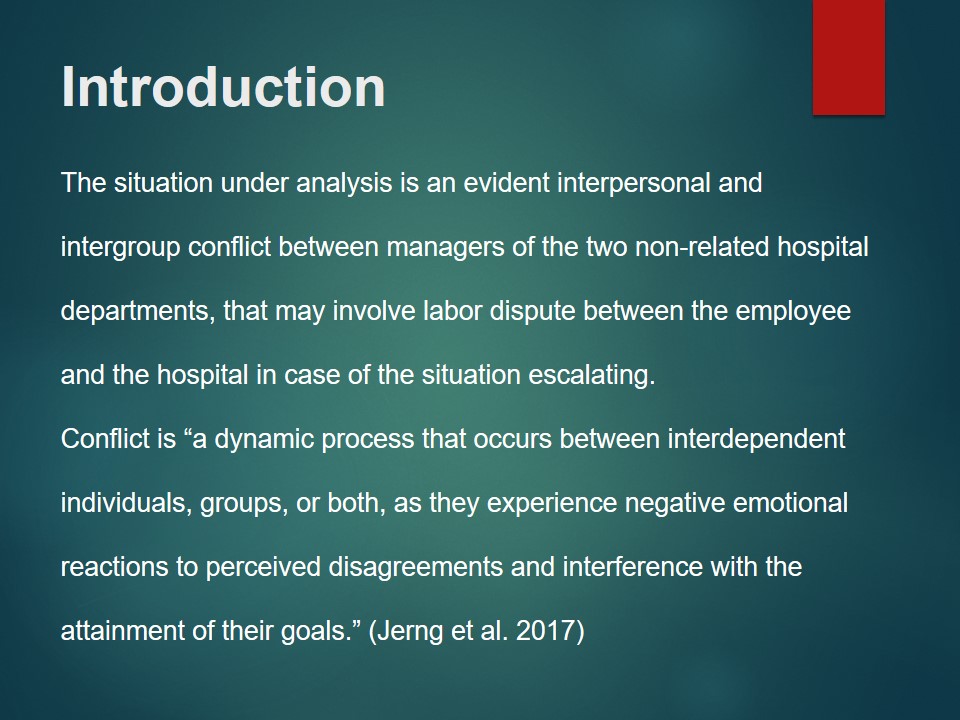
George Mann’s Argument
- It is his department’s employee. This employee has worked overtime during the last month;
- Original arrangement between the employee and Mann;
- The employee might work 2 extra hours next day;
- The counterpart is trying to work towards promotion;
- Carter was showing disrespect towards Mann.
It is his department’s employee. This employee has worked overtime this month due to great workload connected with an update of the façade without being paid for it. The original arrangement was that the employee would be able to take extra time for personal business without punching out on the grounds on netting. The employee might work 2 extra hours next day. So, it is particularly an intra-departmental business which does not impede the health care process and is not connected to the performance of the whole organization. However, as a result of this interference of another department’s supervisor, the employee feels frustrated, let down, and unwilling to work extra time when it is required.
The counterpart is trying to work towards promotion.
Carter was showing disrespect towards him. She was patronizing him and talking in a condescending manner saying that he “had no business doing what he had done and that it was his poor management that had caused the employee to suffer.” Mann interpreted these words as direct aggression and disrespect vented on him and felt offended and resentful. It is not within her competence to judge him or assess his management as he reports directly to the CEO.
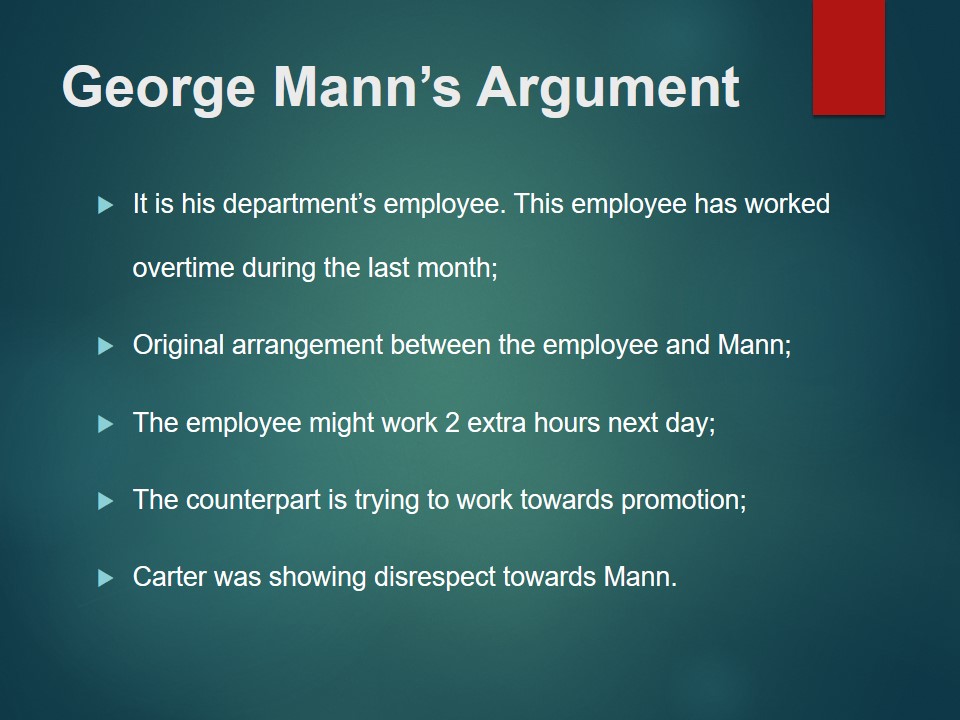
Sally Carter’s Argument
- Numerous violations of the administrative polices detected in the maintenance department.
- There is no difference between the curing staff and the maintenance staff in terms of discipline.
- It is her duty as a Chief of the HR and Payroll departments to ensure adherence to guidelines.
As Sally Carter claims the violations related to working hours in the maintenance department have been detected long ago. She has repeatedly warned Mann about possible consequences but each time she got the same answer that it was not her business. She believes that this practice leads to the lack of discipline among the workers of the whole department which may have a spillover effect in the rest of the hospital.
Carter claims that all the employees are equal in the face of the hospital’s policy, and no exclusions should be made. It’s the hospital’s policy to ensure the quality healthcare services on each level and it is her duty as a Chief of the HR and Payroll departments to ensure adherence to guidelines.
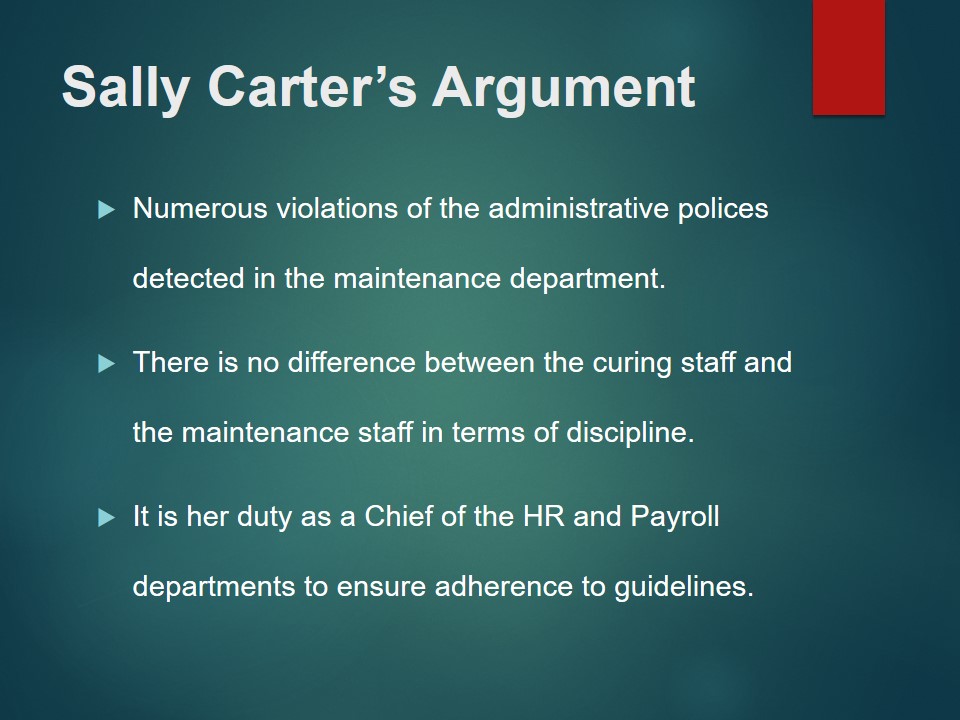
CEO’s Decision
Grounds
“Conflict management is an international attempt by supervisors to enter into employees’ grievances or dispute in order to alter or influence the situation to minimize its undesirable outcomes.” (Akuffo 2015, p. 29).
It is necessary to mention that “the perception of conflict has changed dramatically. It turned from authoritative approach with ignorance towards other parties to cultural awareness, value creation and skills in advocacy, listening and negotiation.” (Prause and Mujtaba, 2015, p.14).
In order to manage this situation successfully, many physiological factors must be considered, such as type of conflict, conflict management style, conflict style, and the overall approach. However, prior to that the hospital’s organizational structure, existing policies and facts should be given consideration.
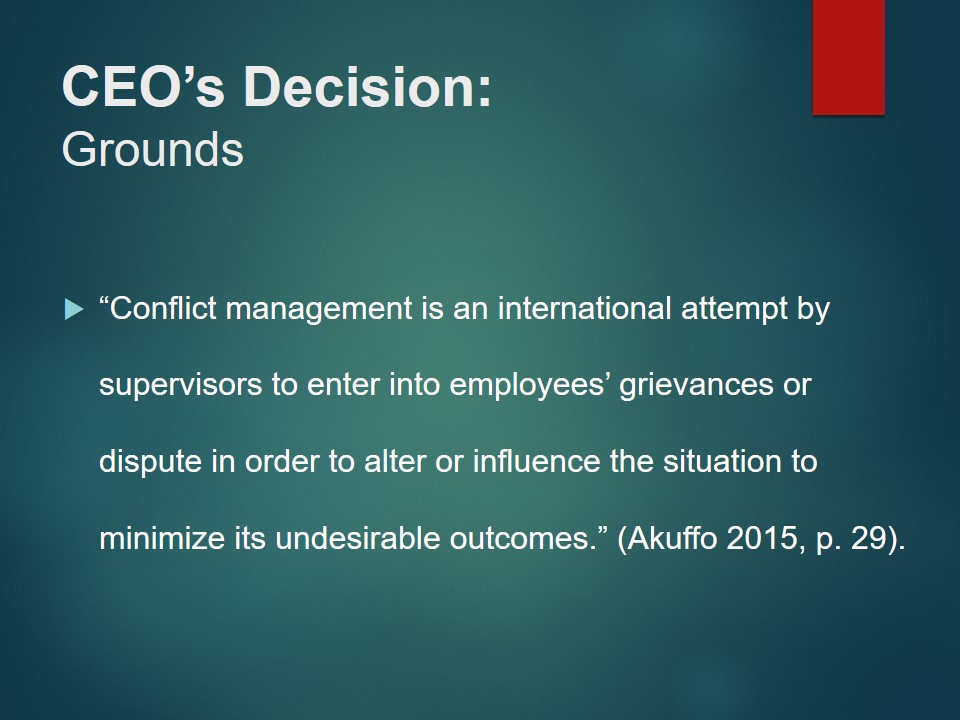
Organizational structure
- Administrative services (CEO, Vice President(s), Executive Assistants, Department Heads).
- Informational services (Admissions, Billing, Medical Records, Health Education, Human Resources, etc.).
- Therapeutic services (Therapy, Pharmacy, Nursing, Dietary).
- Diagnostic services (Laboratory, Radiology, Nuclear Medicine, Cardiology, Neurology).
- Support services (Central supply, Housekeeping, Maintenance, etc.).
The common organizational structure of a small hospital might look as presented on the slide 6. Usually, smaller hospitals have simple vertically organized structure with a well-defined top-down hierarchy. It means that each member of the staff has certain responsibilities and reports directly to their superior. So, before starting to manage any conflict it is necessary to keep in mind the roles and hierarchy positions of the participants of the conflict and then investigate the situation.

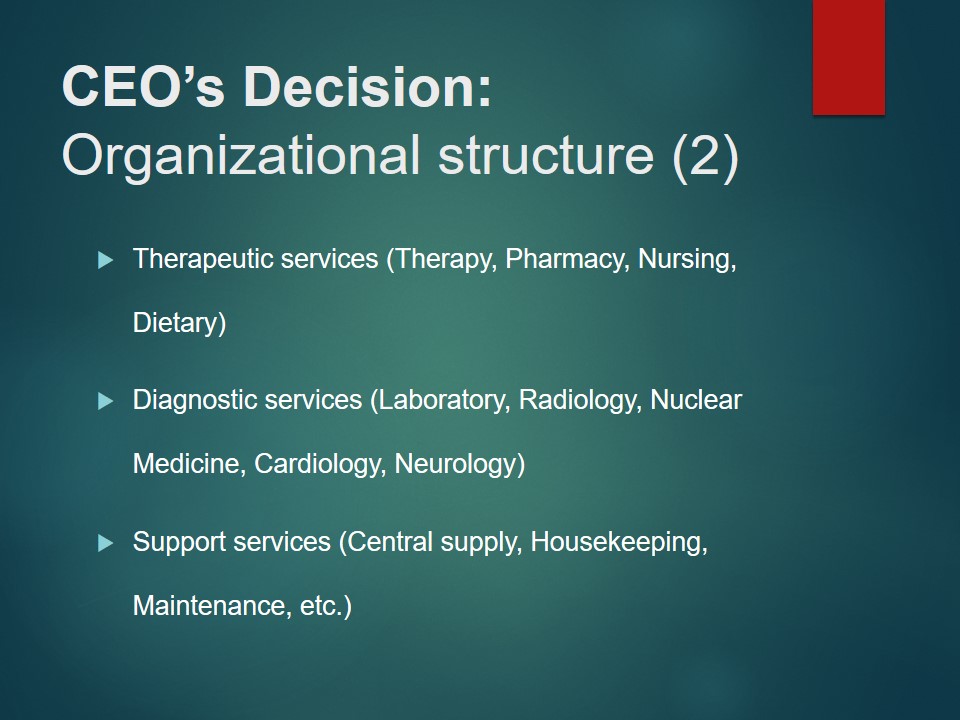
Characteristics of the present conflict
- Type of conflict: Interpersonal and intergroup conflict;
- Sources of origin:
- Misunderstanding of the hospital administrative policies;
- Misunderstanding of the roles in the hospital hierarchy.
- Type of handling the conflict: dominating from both parties.
There is a personal conflict taking place involving systematic miscommunication and mutual disrespect between the supervisors of the maintenance and HR and payroll departments.
As it has already been said, this conflict has a complex nature as it is both an interpersonal and an intergroup conflict. The sources of conflict lie within the misunderstanding of the hospital administrative policies and personal roles. The hidden agenda might refer to the supervisors’ desire to get a promotion or mutual irritation. However, it is important to take into account that Mann and Carter are not in the superior-subordinate relationships and report directly to the CEO.
Another important factor that allows the CEO to analyze the situation is the style of handling the conflict adopted by the participants. There are five different conflict handling styles derived from classical Thomas and Kilmann model by Akuffo (2015) :
- Dominating style of handling conflict basically occurs when one party decides to employ tactics to achieve his/her objective without considering its consequences for the other party. This style has high concern for self and low concern for others.
- Integrating style is usually used when parties to conflict normally decide to find solutions which would be acceptable to both parties, to relieve the pending conflict and tension between them.
- Avoiding style is where parties to conflict sometimes pretend as if there is no conflict, stay away or withdraw from the substance of the conflict.
- Compromising style is associated with concern for self and others. Here, parties deliberately come to consensus to forego something which is very important to both parties for agreement to be reached.
- Obliging style is where a party to the conflict decides to satisfy the interest of the party at his own expense.” (Akuffo 2015, p. 28).
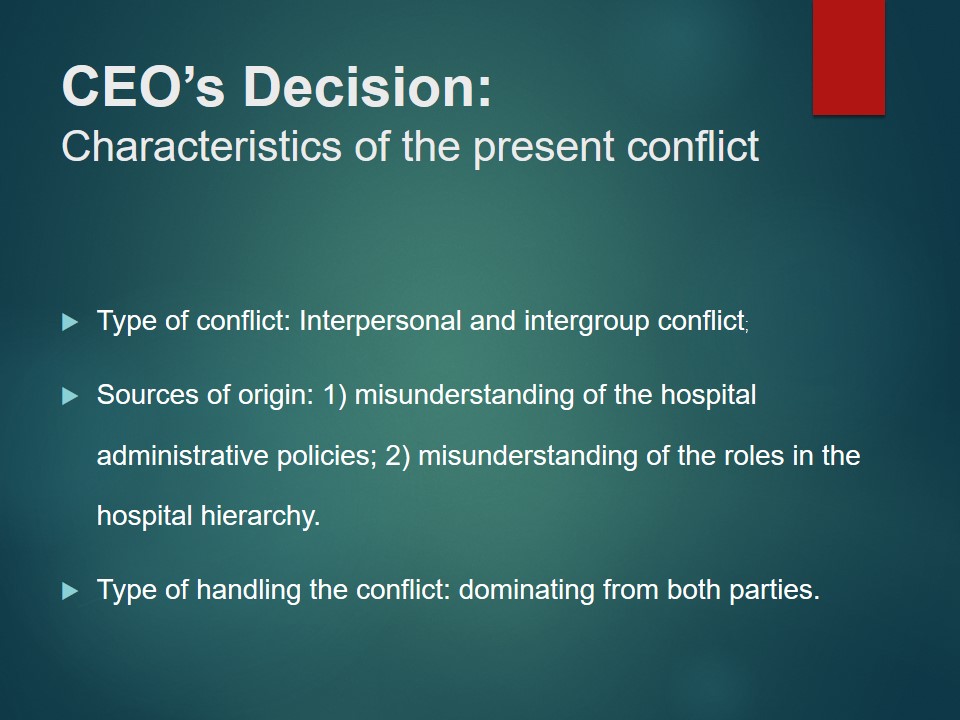
Guideline
Follow the 8 stages model to adopt a beneficial strategy:
- Develop ground rules;
- Select a facilitator;
- Uncover the details of the problem and its history;
- Check for the facts and clarify perceptions;
- Focus on individual and shared needs;
- Develop multiple options for solving the issue;
- Develop doable next steps;
- Make mutually beneficial agreements.
Having analyzed the conflict based on theoretical models at hand, CEO might decide to take some disciplinary actions in order to correct the behavior of all participants of the conflict and create a precedent. Otherwise, to create the atmosphere of trust and respect the most appropriate course of action would be to adopt such a style that would allow focusing on the conflict participants’ needs. To navigate this conflict, the CEO might consider following certain steps:
- Develop ground rules:
- Check the current administrative policies;
- Bring the administrative and HR policies to attention of the departments’ supervisors and other staff members;
- Bring the organizational structure and hospital hierarchy to attention of supervisors and the personnel.
- Select a facilitator – in this case the facilitator is the CEO; “Mediation refers to the attempt to resolve a conflict with the help of a trained third party who does not impose a solution, but instead performs some combination of communication, facilitation, issue identification, and input on potential solutions.” (Leiter 2015 p. 306);
- Uncover the details of the problem and its history – it is important to make sure that all the voices of the story are heard, including the employee;
- Check for the facts and clarify perceptions – the CEO is to investigate the situation, check the time card of this employee to clarify whether it is true that he has repeatedly overworked; to pay his extra hours and deduct payment for the time he had dedicated to his personal business (1,5 hours, excluding time he spent on checking the functional duties of the supervisors.
- Focus on individual and shared needs – it is necessary that these needs were conveyed properly by the participants;
- Develop multiple options for solving the issue – this step depends on the situation. As for this particular conflict, there can be one possible decision;
- Develop doable next steps – will be discussed further,
- Make mutually beneficial agreements.
To summarize, this conflict might be seen as beneficial indicating those areas in overall management that require attention equally to the delivery of health care services.
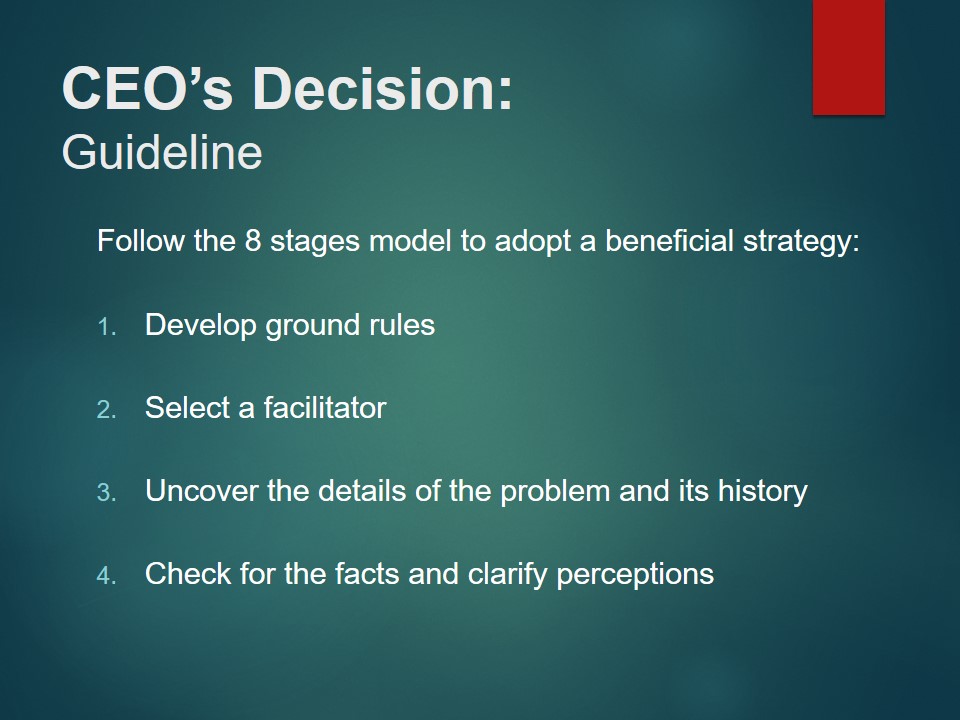
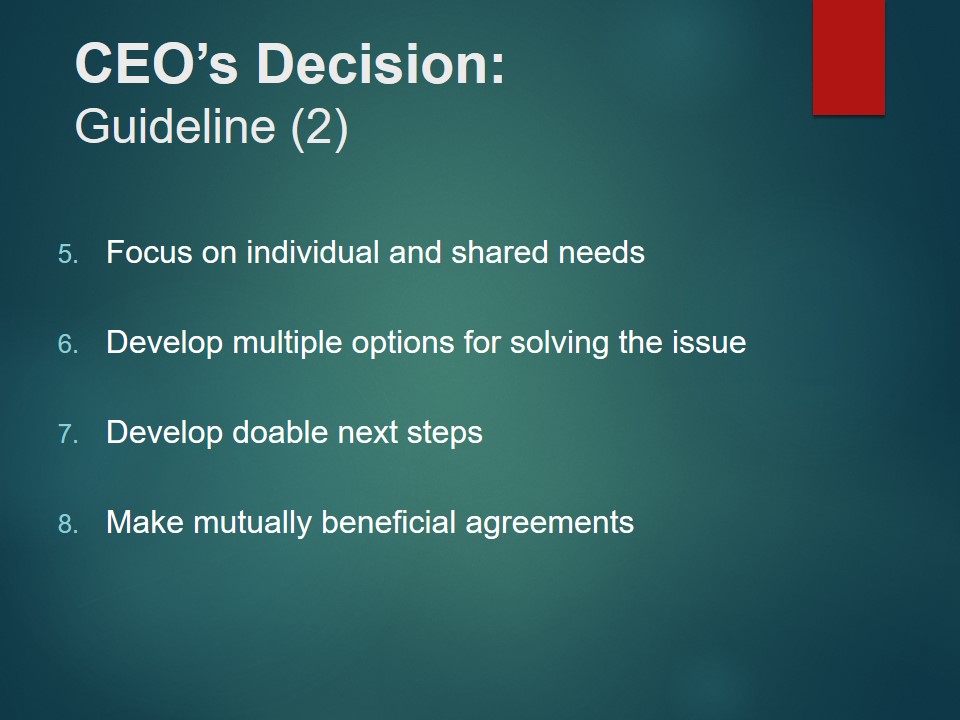
Steps to Be Considered
- Check hospital policies.
- Bring the administrative and HR policies to attention of the departments’ supervisors and other staff members.
- Bring the organizational structure and hospital hierarchy to attention of supervisors and the personnel.
- Improve methods of communication and managing interpersonal and intra-group conflicts, (Jerng J-S et al. 2017), for example, the incident reporting system could be used to report conflicts.
- Organize refresher courses on conflict management for supervisors’ and subordinates.
Conflict should be resolved at as low an organizational level as possible.
Top levels of management should be involved only rarely in conflicts within the organization, because their involvement might give undue weight to the problem, establish precedent, and force the setting of policy that escalates resolutions to a higher level.
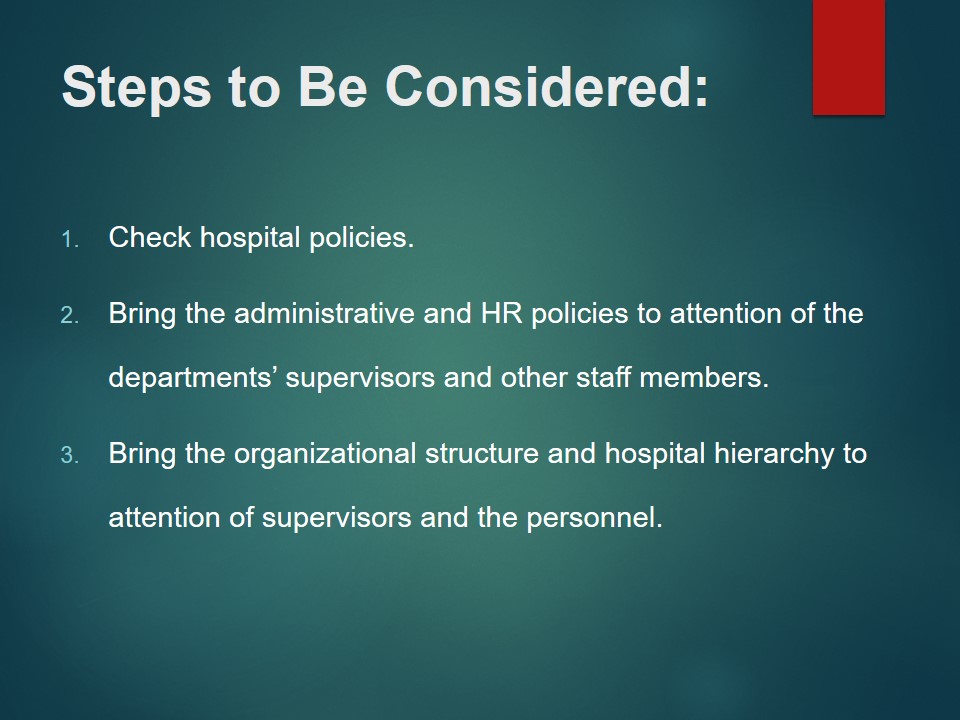
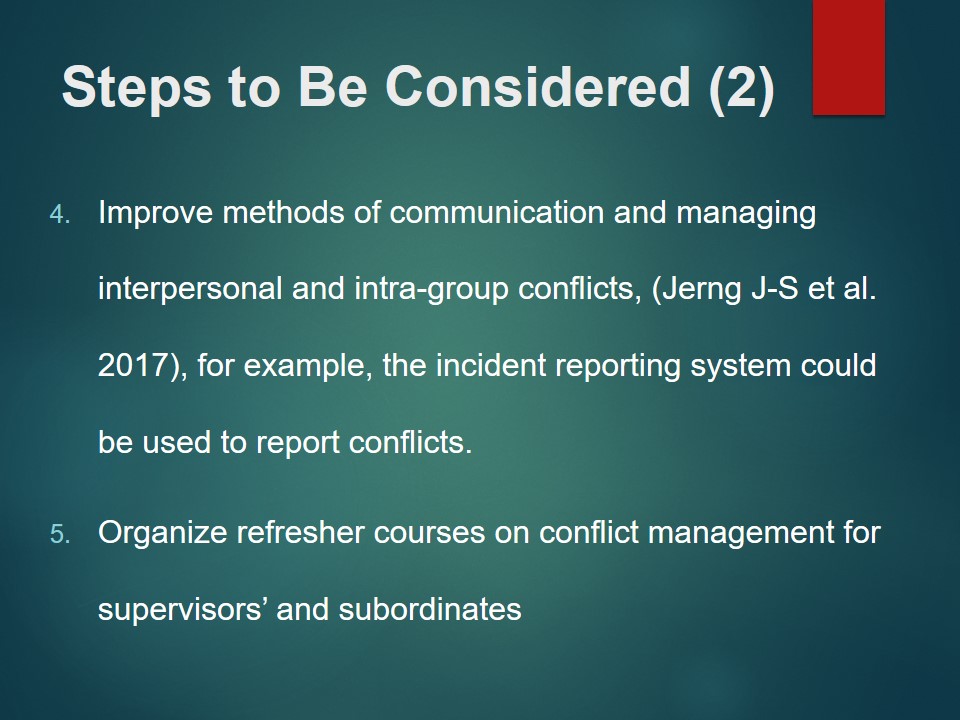
Conclusion
- Not to hide from conflicts;
- Use them as a trampoline for future success;
- Not to favor one party over another;
- The decision should be taken on legitimate basis.
This interpersonal and intergroup conflict might have a detrimental impact on performance and personal relationships, creating an atmosphere of hostility and disappointment. Reduced performance will have a direct impact on patient care and so these factors must be addressed in the first place. To manage such conflict, it is necessary to understand its source and origin. Yet, such conflicts are an inevitable part of the working process and when managed properly, they can promote sufficient improvement in overall management. Successful conflict resolution will prevent escalation and put all the participants in their places with understanding of roles.
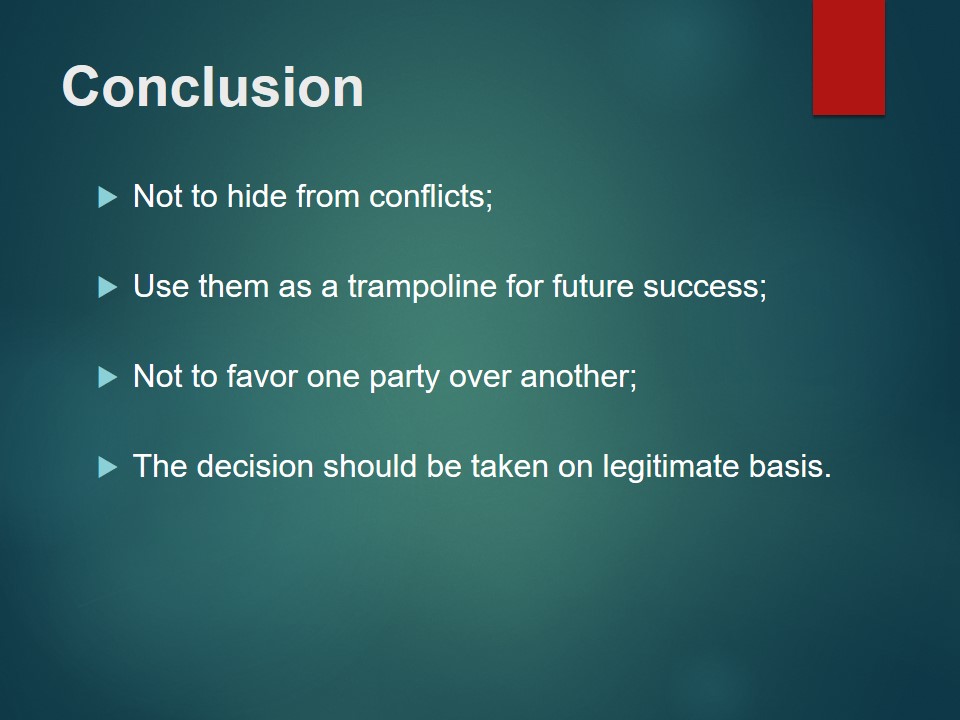
References
Akuffo, I. N. (2015). The influence of supervisor’s conflict management style on employees’ counterproductive work behaviors. European Journal of Business and Management, 7(9), 28-33.
McKibben, L. (2017). Conflict management: importance and implications. British Journal of Nursing, 26(2), 100-103.
Jerng J. S., Huang S. F., Liang H. W., Chen L. C., Lin C. K., et al. (2017) Workplace interpersonal conflicts among the healthcare workers: Retrospective exploration from the institutional incident reporting system of a university-affiliated medical center. PLOS ONE 12(2): e0171696. Web.
Gilin Oore, D., Leiter, M. P., & LeBlanc, D. E. (2015). Individual and organizational factors promoting successful responses to workplace conflict. Canadian Psychology/psychologiecanadienne, 56(3), 301.
Prause, D., & Mujtaba, B. G. (2015). Conflict management practices for diverse workplaces. Journal of Business Studies Quarterly, 6(3), 13.